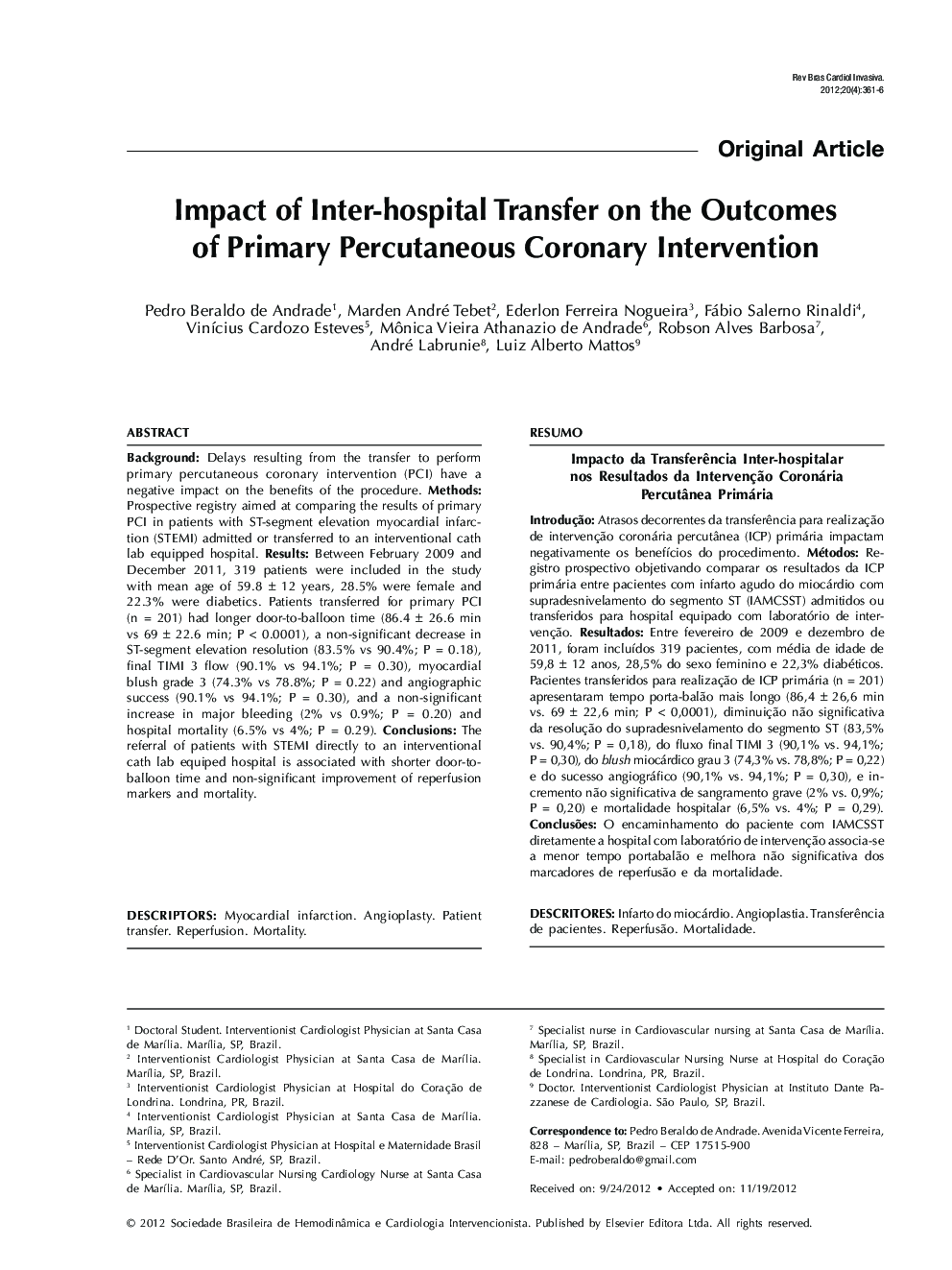| کد مقاله | کد نشریه | سال انتشار | مقاله انگلیسی | نسخه تمام متن |
|---|---|---|---|---|
| 3011767 | 1579012 | 2012 | 6 صفحه PDF | دانلود رایگان |

ABSTRACTBackgroundDelays resulting from the transfer to perform primary percutaneous coronary intervention (PCI) have a negative impact on the benefits of the procedure.MethodsProspective registry aimed at comparing the results of primary PCI in patients with ST-segment elevation myocardial infarction (STEMI) admitted or transferred to an interventional cath lab equipped hospital.ResultsBetween February 2009 and December 2011, 319 patients were included in the study with mean age of 59.8 ± 12 years, 28.5% were female and 22.3% were diabetics. Patients transferred for primary PCI (n = 201) had longer door-to-balloon time (86.4 ± 26.6 min vs 69 ± 22.6 min; P < 0.0001), a non-significant decrease in ST-segment elevation resolution (83.5% vs 90.4%; P = 0.18), final TIMI 3 flow (90.1% vs 94.1%; P = 0.30), myocardial blush grade 3 (74.3% vs 78.8%; P = 0.22) and angiographic success (90.1% vs 94.1%; P = 0.30), and a non-significant increase in major bleeding (2% vs 0.9%; P = 0.20) and hospital mortality (6.5% vs 4%; P = 0.29).ConclusionsThe referral of patients with STEMI directly to an interventional cath lab equiped hospital is associated with shorter door-to-balloon time and non-significant improvement of reperfusion markers and mortality.
RESUMOImpacto da Transferência Inter-hospitalar nos Resultados daIntervenção Coronária Percutânea PrimáriaIntroduçãoAtrasos decorrentes da transferência para realização de intervenção coronária percutânea (ICP) primária impactam negativamente os benefícios do procedimento.MétodosRegistro prospectivo objetivando comparar os resultados da ICP primária entre pacientes com infarto agudo do miocárdio com supradesnivelamento do segmento ST (IAMCSST) admitidos ou transferidos para hospital equipado com laboratório de intervenção.ResultadosEntre fevereiro de 2009 e dezembro de 2011, foram incluídos 319 pacientes, com média de idade de 59,8 ± 12 anos, 28,5% do sexo feminino e 22,3% diabéticos. Pacientes transferidos para realização de ICP primária (n = 201) apresentaram tempo porta-balão mais longo (86,4 ± 26,6 min vs. 69 ± 22,6 min; P < 0,0001), diminuição não significativa da resolução do supradesnivelamento do segmento ST (83,5% vs. 90,4%; P = 0,18), do fluxo final TIMI 3 (90,1% vs. 94,1%; P = 0,30), do blush miocárdico grau 3 (74,3% vs. 78,8%; P = 0,22) e do sucesso angiográfico (90,1% vs. 94,1%; P = 0,30), e incremento não significativa de sangramento grave (2% vs. 0,9%; P = 0,20) e mortalidade hospitalar (6,5% vs. 4%; P = 0,29).ConclusõesO encaminhamento do paciente com IAMCSST diretamente a hospital com laboratório de intervenção associa-se a menor tempo portabalão e melhora não significativa dos marcadores de reperfusão e da mortalidade.
Journal: Revista Brasileira de Cardiologia Invasiva (English Edition) - Volume 20, Issue 4, 2012, Pages 361–366